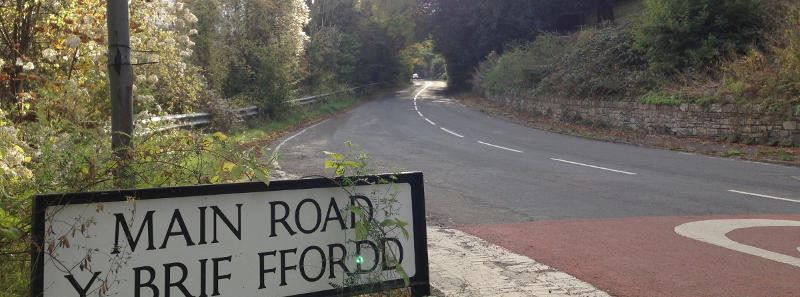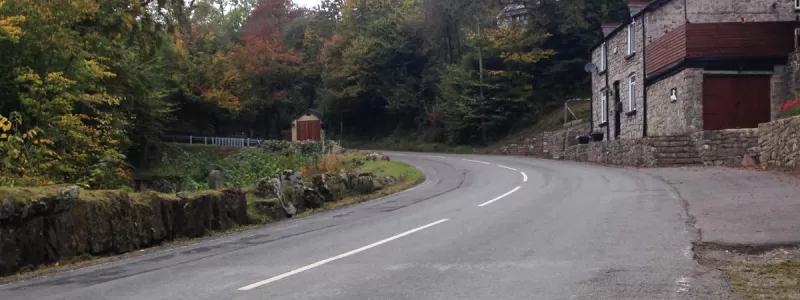Section I of the new road would run from Abergavenny to Brynmawr, a seven-mile (11 km) journey that began in the low ground of the Usk Valley and climbed 290 metres (950 ft) in altitude to Brynmawr by threading its way up the steep-sided Clydach Gorge. The section on low ground was simple roadbuilding, but involved a new bridge over the Usk; the part that ran up the gorge would mean blasting a shelf for the new road out of sheer rock faces and overcoming numerous other geological obstacles.
John Morgan (Builders) Limited, a civil engineering firm based in Cardiff, won the contract for this complex task. The tender documents, drawn up under the Ministry of Transport and Civil Aviation but issued after a reorganisation under the new Ministry of Transport, had the words "and Civil Aviation" carefully crossed out in fountain pen on each page. They listed all manner of bridges, viaducts, culverts, excavations, retaining structures and other difficult business. Morgan's company somehow arrived at the admirably precise offer of £1,333,912.1.9d (what difference one shilling and ninepence would make is not recorded), and as the lowest bidders were awarded the job. They would later regret having become involved at all.
A small inauguration ceremony was held on 30 March 1960 to mark the start of works on the Heads of the Valleys project, where Lord Brecon, Minister of State for Welsh Affairs, made a particularly enthusiastic speech. He talked with great excitement about linking West South Wales with the Midlands, and thanked the Ministry of Transport for their far-sighted plan.
"Apart from strengthening the links between main centres the new roads will do a great deal to open up the country through which they pass to tourist and industrial development...
"It is a fact that this new road will make an important contribution to reviving the fortunes of this area and that today we are witnessing the beginning of a second industrial era for the towns at the heads of the valleys."
Brecon's speech also mentioned John Morgan's company as the "foremost firm of Welsh Civil Engineering contractors", said that he was delighted when he learned that they had won the contract, and finished by wishing all who worked on the new road "good luck and godspeed". They were going to need all the luck they could get.
Moving out
The Clydach Gorge does not provide much space for roadbuilding, and to get the new road through, houses had to be demolished in several places, most notably in the tiny village of Blackrock. As early as 1955 this was causing headaches for both the Ministry and the local authority, Crickhowell Rural District Council. Nineteen houses were affected by the new road, and in 1959 work began to move the residents elsewhere.
The expectation was that the council would build an equivalent number of new council houses, and the Ministry would pay for them. But for some reason these 19 homes caused no end of trouble. Rehousing didn't seem to be a practiced or routine process, even though people were being displaced for new roads all over the country at the same time. Perhaps the difficulty was because roadbuilding had not happened much since the outbreak of war in 1939, least of all here in mid-Wales, and there still remained many people working in local authorities and the Divisional Road Engineer's office in Cardiff who were inexperienced in dealing with it. As a result, even routine problems were a complete novelty, to the great frustration of the people who were being asked to move.
Several of the houses were owned by their occupiers, who refused to move into rented council houses and expected to own their new homes, which caused an administrative logjam. Worse, all the others had private landlords and paid very low rents — at a time when council houses were much sought-after and not always competitively priced. The Clerk of the Council wrote that none of those affected were likely to agree to moving into a council house and "paying the high rents now necessary".
There was also no way to deal with the fact that Blackrock was on the edge of Crickhowell, and the nearest town, Brynmawr, was over the border in another council district. Many of those who had to move wanted to go to their nearest town, but Crickhowell could only offer them houses in Gilwern, some miles away at the bottom of the valley. Brynmawr Urban District Council refused to cooperate.
The Ministry of Transport's handling of the matter was, at best, inelegant. It offered to subsidise the rents of those moving to council houses to the tune of £22 a year, to offset their new higher living costs, but Crickhowell's council said that was not nearly enough. Those who owned their houses were disappointed to find that government policy didn't even allow them the market price for their house — so they now couldn't afford to buy another one.
One owner-occupier was a 90-year-old widow, Mrs Powell, who had lived in Pink House at the bottom of the gorge for fifty years. She was offered compensation of £750, and declared ineligible for a council house, but the going rate for houses in Gilwern was upwards of £2,000 and her daughter wrote to the Ministry in London in a state of some distress about their casual approach to making her housebound mother homeless. For six whole months, neither the council nor the Ministry could find a solution. Fate came to the rescue in January 1960 when another person displaced by the new road died. His brand new council bungalow on Brynglas in Gilwern was offered to Mrs Powell, much to her daughter's relief.
With the residents of Blackrock out of the way, Morgan's workmen could get to work clearing the site and blasting rock, and the Ministry's focus turned to the next stage.
Picture credits
- Artist's impression of the Usk Bridge extracted from BD 24/341.



